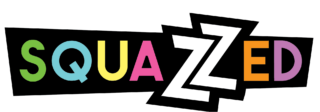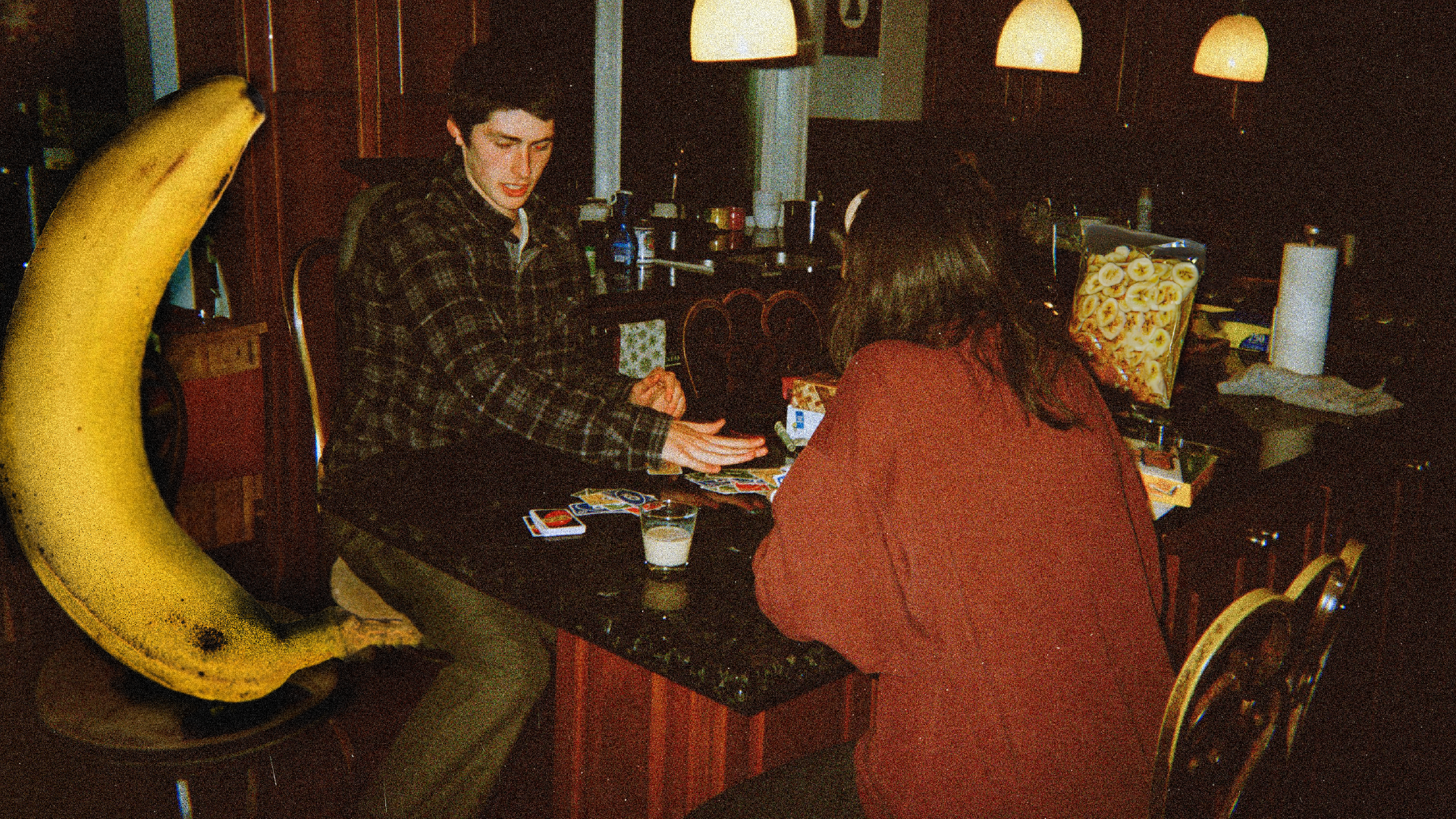Your cart is currently empty!
The Classic Board Games Tier List
Shakespeel
Ahh, the olden days of rolling dice and throwing cards while the power was out in the trailer park, quietly moving our game pieces to not disturb Uncle Bob in his drunken stupor. Remember those times? No, just me?
Regardless of your childhood trauma or lack-thereof, you’ve most likely played at least one of these old classic games. So, here we are to provide our absolutely objective opinion on how they stack up against each other!
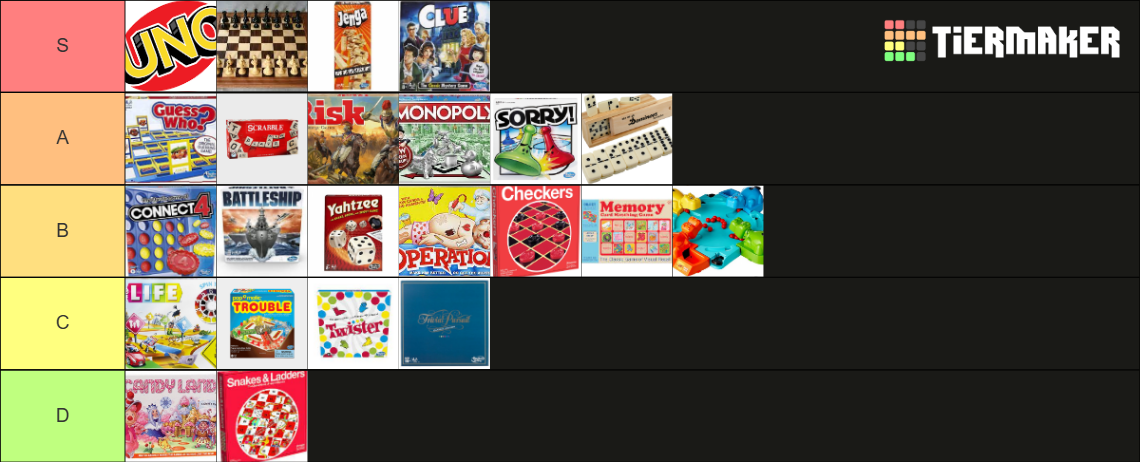
The Tiers
If you’ve seen a tier list before, you know the drill. S is the best; D is a dud. And placements within the tiers matter here, so the leftmost of each row is the highest ranked of its tier.
Also, I’m not going to really explain the rules to each and every game. So if you haven’t played it, well. . . sorry, Zoomers.

Tier: S
Uno
This game is perfect for almost any occasion. Group of friends? Uno. On a date? Uno. Deciding who gets what in the divorce? Uno!
Mechanically, it allows for plenty of player agency, but the card-draw element gives it enough randomness to keep you on your toes. There are even moments of player politics, using Skips and Draw 2’s to make allies or ruin friendships.
And the rules are fluid enough to mix up how you play! Spicy Uno, for example, is a variation where different things happen depending on the number played.
Chess
Many would consider Chess to be a perfect game. No chance, and all information is available to both players. The advantage that White gets only really shows up at higher levels of competitive play.
The skill ceiling for Chess is skyscraping, which shows why it has garnered thousands of fans and built up a cultural scene for itself. People play for years and still learn new things, reapplying fundamentals in creative ways.
Jenga
Sure, the gameplay loop of Jenga doesn’t really change too much. But you’ll still have a hard time growing bored during a game.
Jenga is several rounds of constant tension. If you want to win this game of hot-potato-bomb-defusal, you need to be a daredevil.
Clue
We’re doing a total 180 from Jenga, but Clue is the best here at what it does. Methodical gameplay and information gathering.
Dice-based movement is a downside, though secret passages help keep the pacing up. The meat of the game, though – guessing and eliminating the locations, suspects, and murder weapons used – is always exciting.
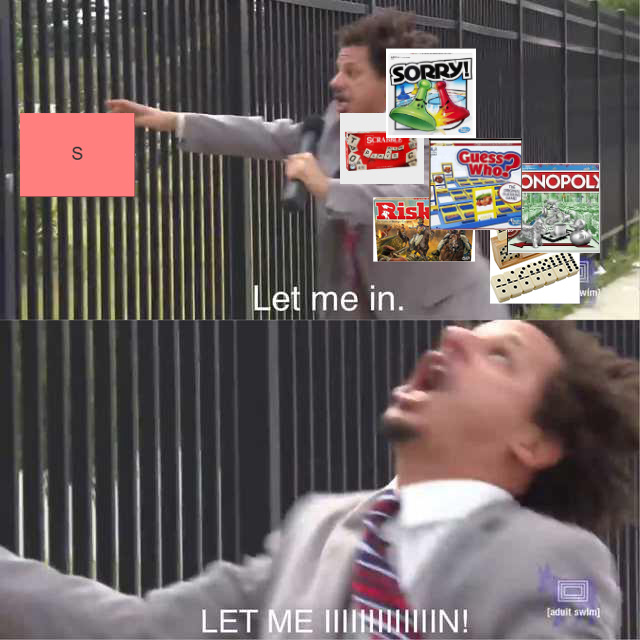
Tier: A
Guess Who?
Another fun guessing game. Guess Who? is all about asking the right questions to figure out your opponent’s character before they do. Simple and entertaining, with a low barrier to entry.
It gets more fun when your questions evolve from “do they wear glasses?” to “do they look like an anti-vaxxer?”
Scrabble
Some people don’t see Scrabble for the awesome time it is. And those people clearly weren’t aspiring fan fiction writers in their tweens.
This game rewards creativity. Optimizing the letters and board state to get a triple-point “Chutzpah” never gets old.
Risk
When Mom says “We have Warhammer 40,000 at home.”
Not that that’s a bad thing. Risk is a fun time, with a focus on its namesake. Choosing when to attack and when to build up territories is fundamental, but taking a chance on three units against eight and suddenly coming out on top is disgustingly satisfying.
Monopoly
What may seem like a passive dice-rolling game at first has plenty of mechanics to give it some depth. Combined with a classic art style, and many variations to boot, this game is hard to forget.
Player politics with trading and paying one another can lead to some Squazzy situations!
Of course, once one person gains some momentum, it can snowball pretty quickly from there. Though that is the intended point of Monopoly.
Sorry!
Another classic board game that is less luck-based than it appears.
Sorry! features slick-and-simple board and game piece designs. The rules are straightforward, with card-draw based movement; but this isn’t Candyland.
With multiple pieces for each player to move comes plenty of decision making, meaning you can win with different strategies every game.
Dominoes
One of the older games on the list, Dominoes holds up for its strategic depth. It rewards thinking ahead and creatively adapting to new board states.
Or you can stand them up just to watch them fall (why did you even swipe right on me, Clarice?).
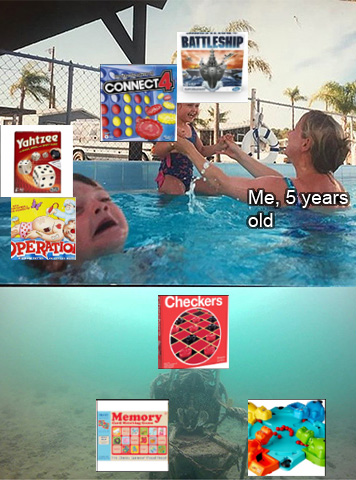
Tier: B
Connect 4
I’m gonna be honest. Connect 4 is a solved game. In the spirit of fun, I won’t tell you here how to always win, but you can basically force it from the start as long as you play correctly.
But aside from that, Connect 4 can be a fun expansion on Tic-Tac-Toe. The rules are simple, but allow for creative choices and some depth, though not to the same degree as something like chess.
Battleship
Battleship has a unique design, with both players using what seems like cool government sonar-computer-remote-missile-launchers. Strategic depth is a little lacking though, for a game that is set in the water.
You can work more efficiently by having a certain pattern, or by looking for a new ship every time you fire until you’ve found them all. But beyond that, there’s not much more to it.
Yahtzee
Yahtzee is a dice rolling game that’s only higher on this list because it feels somewhat exciting. Or maybe I’ve built up a positive association by screaming “Yahtzee!” too many times in situations that don’t call for it.
There’s a slight risk-taking element, but generally it’s all up to the fate of your little cubes. I spice it up by pretending I’m in Pirates of the Carribean, but then, I could just be playing Liar’s Dice. (Grr. . . Four fours!)
Operation
At first, Operation seems like Jenga with its requirement for nimble movement and tense gameplay.
But tension turns to stress quickly as the machine just doesn’t. Stop. Beeping. And as that goes you start caring less and less about whether or not you’re slicing up the man’s internal organs as you just want to get the pieces out and call it a day.
Checkers
Ahh, Chess‘ boring cousin that you say hi to at the Cracker Barrel family dinner . . .
Checkers isn’t the worst. It’s all based on the player’s decisions, and there are some tactics you can learn. But admittedly, it’s a solved game, and perfect play always leads to a tie.
Memory
I enjoy simple memory-guessing games. But in the end, that’s all this is. Simple.
While randomness can come into play, it’s all still down to your choices as a player. But it’s hard to stay entertained by it for a long time.
Hungry Hungry Hippos
This might as well be a carnival game. There’s not really a strategy to it, just raw, ball-munching prowess. It’s got all the fun of a novelty mobile app you only use once to see the spectacle effects, then never again.
Become the hippo. Satisfy your hunger. You must be one with your hippo, and you will devour the world in all of your ungulate glory.
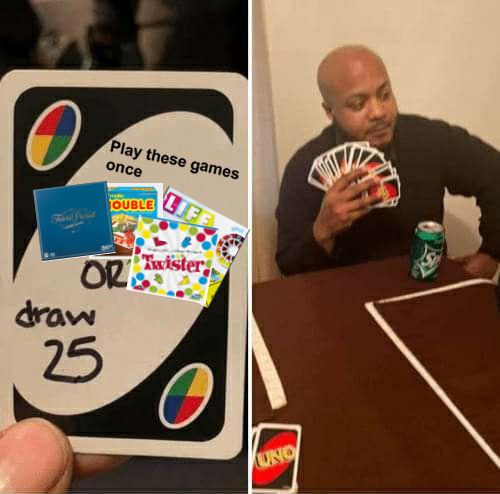
Tier: C
LIFE
Life is like a box of chocolates, chosen in the store by spinning a wheel numbered 1 – 10 for each flavor. And that’s pretty much it.
There’s not much agency whatsoever in the game of Life, but I suppose it’s fun to watch how your marriage ends with 3 kids and a divorce, and you somehow still come out with the most money in the end.
Trouble
Trouble is a piece racing game that feels similar to Sorry! at first, but with much less depth. The only thing it has going for it is the popping dice mechanic.
Admittedly, popping the dice gets my brain stimulated like a cat with a toy mouse. I just need to hit it!
Twister
Twister stands out by making the players the game pieces! It’s too bad that leads to more awkward situations than fun ones.
Sure, when you’re a kid, playing with other kids, it’s innocent fun. But then Uncle Bob puts down his bottle and decides he no longer has scoliosis, and he wants some quality time with the family.
And if you’re playing this as adults, there are more interesting forms of foreplay.
Trivial Pursuit
Want to pretend you’re smart? Boom.
Trivial Pursuit is more chance-based than people realize, and its trivia aspect only rewards players that happen to know random bits of information.
All games with player choice will reward people who study it outside the game, but simple trivia isn’t the same. Other games ask you to learn fundamental strategies, while learning trivia is just studying answers.
It’s like a class that teaches you the answers to problems so you can remember them for the test, instead of teaching you the formulas to solve the problem.
If trivia is really your vibe, I recommend something like Wits & Wagers, so even your friends that aren’t glued to Wikipedia can have fun.
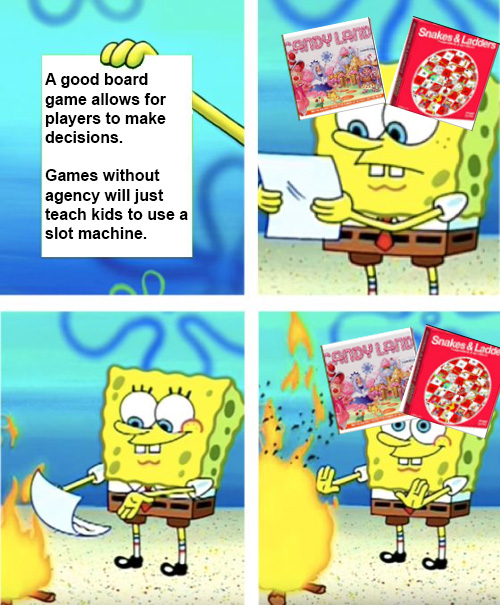
Tier: D
Candyland
Not even worthy of being a kid’s first game. I played this a lot in my first few years of life, but looking back there’s almost nothing going for Candyland. The one pro is that the board can have interesting art. Or maybe I’m just hungry.
But it’s all downhill mechanically. You draw cards and move to the colored spaces shown on them until someone gets to the end. No agency, no choices, and it’s not even or kinesthetically stimulating. RIP.
Snakes And Ladders
The godfather of the most mind-numbingly boring type of game to play. It’s not even visually stimulating. Absolutely zero choice goes into this game, and you’d have more fun watching marbles roll down a slope.
At least there are snakes I guess.
But Where’s X?!
Oh, your favorite game from your childhood that you’ll always remember and cherish forever? Yeah, never heard of it.
Othello? More like, oh, hello? Who’s that stranger at the door? And I didn’t just omit your favorites. I prefer Go, but admittedly it doesn’t quite have the same popularity the listed games have – at least in our target demographic. We’re both suffering here!
But I think I’ve talked about classic board games enough to really hit those SEO keywords! Hopefully we rank high so I can get a lot of negative comments criticizing my placements.
Be sure to sign up for our mailing list so you can hurl more insults at us; and check out our social media so you can reply to our posts with the angry emoji!
